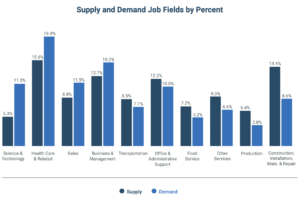(The Center Square) – As the nation’s workforce celebrates Labor Day, a new Missouri report shows the sectors with the most jobs, areas where job seekers are pursuing employment and projected growth. Jobs in health care and technology dominate the current and projected labor market.
“Labor Supply & Demand” was published in July by the Missouri Economic Research and Information Center and the department of higher education and workforce development.
The report examines information from job seekers’ registrations in Missouri’s job-seeker support system, jobs.mo.gov, from May 1, 2020, to May 1, 2021. The analysis also reviewed online job advertisements posted during the same time period.
The research examined approximately 200,000 new job seeker registrations in Missouri’s workforce data system, where job seekers are assigned to an occupation group based on the type of employment they are seeking. Employers posted approximately 600,000 online job ads, according to data from Burning Glass Technologies referenced in the report.
The job seeker registrations represent the available supply of workers currently pursuing employment while the online job postings represent demand for labor.
“While no dataset can fully capture both markets,” the report stated, “it does offer information about the relative gaps present in different job areas. … Jobs in industries such as construction and maintenance are often hired through word of mouth instead of formal job ads placed in the newspaper or on websites, and therefore can be underrepresented.”
The comparison of the two datasets provides a picture of occupational groups where the supply is sufficient or larger to meet employer needs and where there’s a shortage of trained workers.
“Research shows that, with training, employment opportunities exist that can bridge the gaps between labor supply and demand,” the report stated. “Looking at where gaps occur can help guide workers to training for in-demand jobs.
The research found demand significantly exceeded supply in the fields of science and technology and health care. The fields accounted for 31% of ads, but only 21% of job seekers. Sales and business and management also outpaced supply.
Transportation, office and administrative support, food service, production and construction, installation, maintenance and repair had more job seekers than jobs available. Approximately 30% of job seekers sought employment in these fields, but only 19% of job ads were for openings in these areas.
The study also reviewed wages. Business and management positions had the highest average annual wage in 2020 at $90,633 and science and technology jobs was $80,962. (The average wage was $50,140, according to the study.) High wages and the supply-and-demand gap in these fields could influence and incentivize job seekers to pursue additional education and training.
The study also examined projected demand in occupations during the next 10 years. Approximately 16% of projected annual openings in the next decade will be in health care, currently the group with the largest gap. The science and technology group is projected to grow 10.5%, or approximately 15,000 new jobs.
“With only 5.3% of job seekers looking for work in these occupations, combined with a large current demand and strong projected growth, there are job opportunities in technology for workers wanting to expand their skill set,” the report said. “In addition, as technology changes, additional skills and training may be needed to be successful in these occupations.”
The gender of job seekers in the study was 52% male and 48% female. Approximately 48% completed some college courses or earned an associate’s degree or higher. Sixteen percent didn’t complete high school and 36% had a high school diploma or the equivalent. Almost one-fourth of job seekers were under age 25.

The supply of those seeking employment and job demand in various sectors by percentage in Missouri from May 1, 2020, to May 1, 2021.
Missouri Economic Research and Information Center/Missouri Department of Higher Education & Workforce Development

